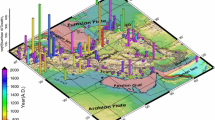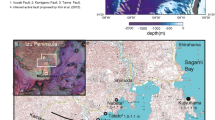Summary
Elastic strain rebound increments for the Hindukush region has been studiedwhich revealed a cyclic pattern of strain release in this area where the rate of strain release decreases with time. The spatial distribution of earthquakes clearly defines the Pamir knot where most of the shocks are concentrated. The dip of the deep seated fault which produces the earthquakes so frequently comes out to be 54° dipping in the northwest direction. This fault is best developed between 70 to 300 kilometers and perhaps both these levels represent tectonic discontinuities.
Similar content being viewed by others
References
S. K. Banerjee,Earthquakes in the Himalayan region, (Indian Assoc. for the cultivation of Science, Jadavpur 1957).
S. M. Mukherjee andA. R. Pillai,The Hindukush earthquake of November 21, 1939, I.M.D. Scientific notes vol. VIII,91 (1940), 85–90.
M. S. Krishnan,Tectonics of India, Sym. of Tectonics, Nat. Inst. of Sciences (1965), 1–25.
H. Benioff,Seismic evidence for the fault origin of oceanic deeps, Bull. Geol. Soc. Am.60 (1949), 1837–56.
H. Benioff,Global strain accumulation and release as revealed by great earthquakes, Bull. Geol. Soc. Am.62 (1951), 331–338.
H. Benioff,Orogenis and deep crustal structure-additional evidence from Seismology, Bull. Geol. Soc. Am.65 (1954), 385–400.
H. Benioff,Seismic evidence for crustal structure and tectonic activity, Bull. Geol. Soc. Am. Spee. paper 62, pp. 61–74.
C. F. Richter,Elementary Seismology (W. H. Freeman and Co., San Francisco 1958).
B. Gutenberg andC. F. Richter,Seismicity of the Earth and associated phenomena, 2nd Ed. (Princeton Univ. Press 1954).
David Griggs,The creep of rocks, Jour. Geol.67 (1939), 25–251.
David Gutts andDavid Himmelfarb,The creep phenomena in ropes and cords, Am. Soc. Test. Mat. Pr.,40, 1940), 1251.
R. K. S. Chouhan,Regional strain release characteristics for Indian regions, Bull. Seis. Soc. Am.56 (1966), 749–54.
A. R. Ritsema,The fault plane technique and the mechanism in the focus of the Hindukush earthquakes, Indian Jl. of Met. and Geophys.6 (1954) 41–50.
Author information
Authors and Affiliations
Rights and permissions
About this article
Cite this article
Chouhan, R.K.S. Seismotectonics of Hindukush. PAGEOPH 82, 108–118 (1970). https://doi.org/10.1007/BF00876173
Received:
Issue Date:
DOI: https://doi.org/10.1007/BF00876173




